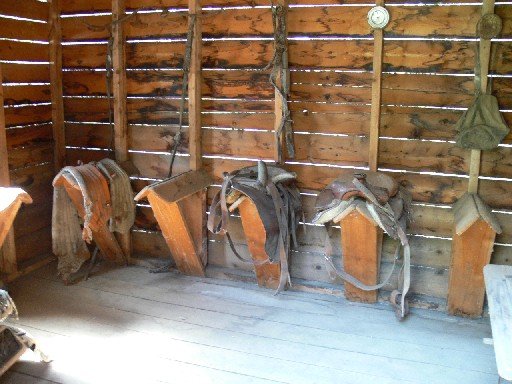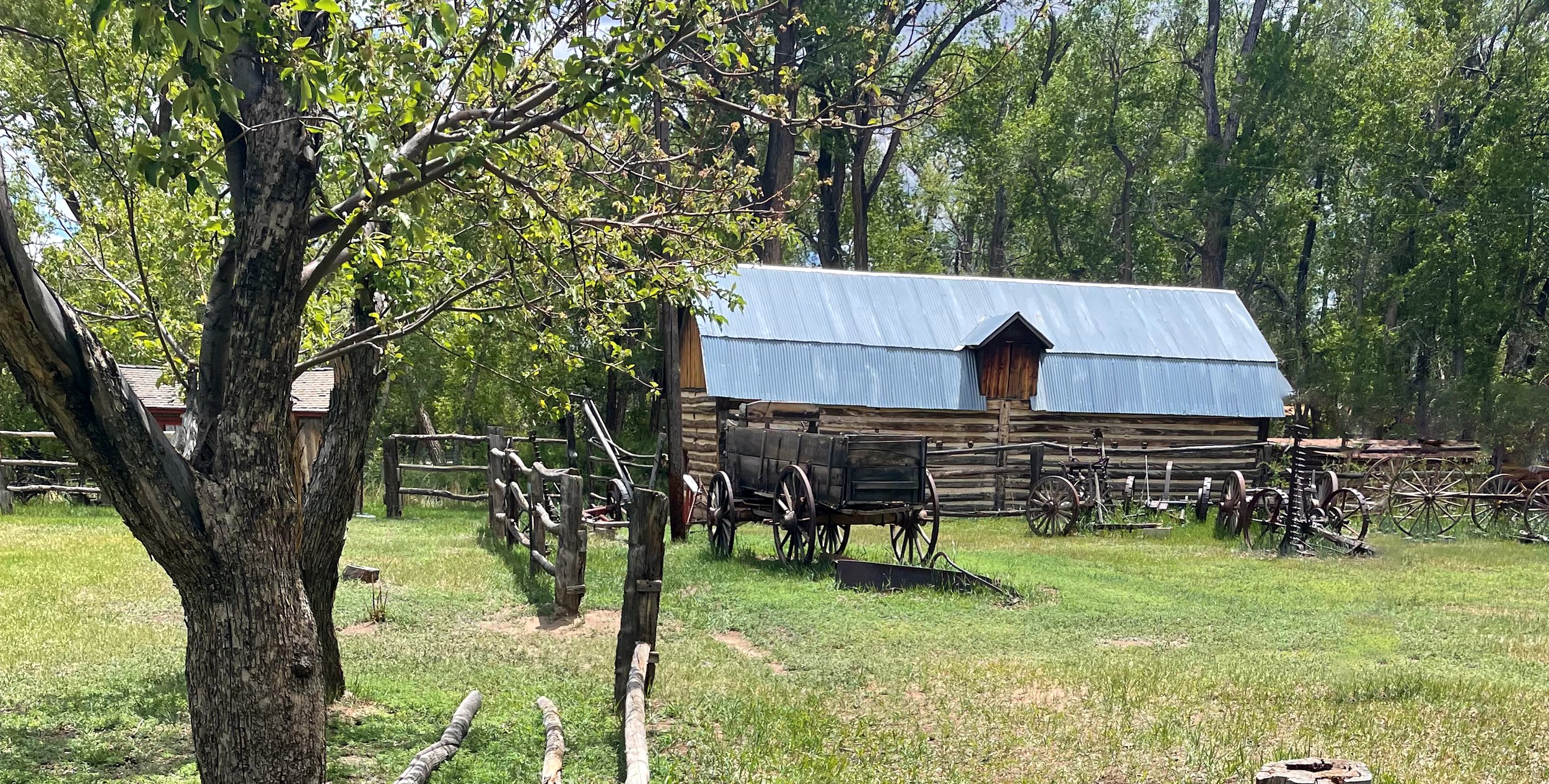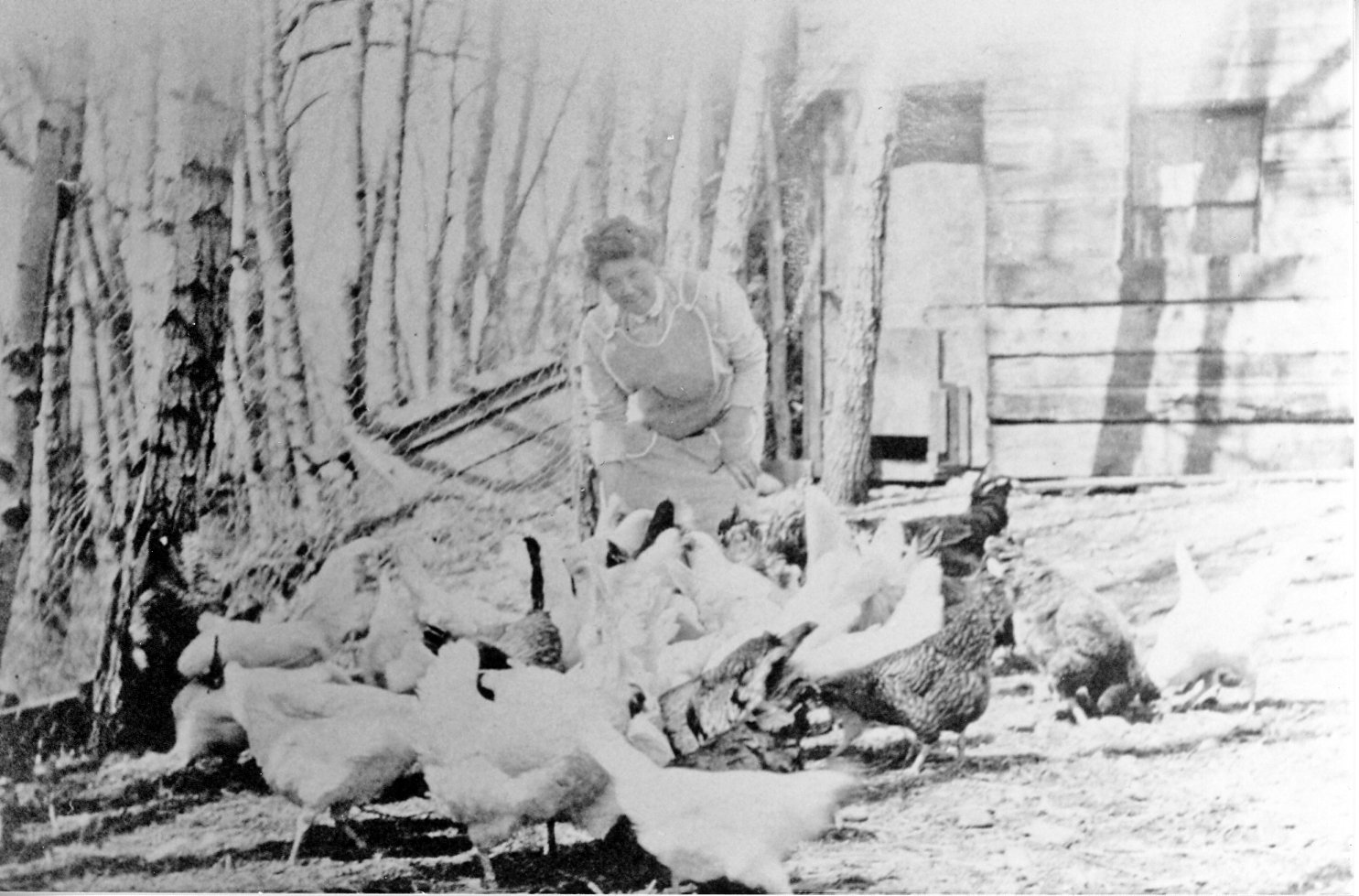History of Turner Farm
Due to the proximity to Town, the property could take advantage of, and tap into, the town water system and electricity provided by the hydroelectric plant on the Arkansas River. A primitive septic system was constructed east of the house, with gray water used for irrigation. When constructed, the house was one of few residences in the area with water and electricity as original features.
The Farmhouse was constructed as a two-story frame structure with a gable roof and painted wood siding. It included three bedrooms, a larger common room upstairs, a living room, a dining room, a full bath, and a kitchen downstairs. The upstairs was reached by an enclosed central stairway. A spacious crawl space and partial basement were also installed during construction. A covered porch also dates to the construction of the house along the front and west side. The house and porch were roofed with shake shingles.
Interior embellishments consisted of fir flooring, trim, molding, and half-light etched glass doors at the front and side entries. All interior walls were wallpapered, and all woodwork was stained. Plain trim was used on the house's exterior, except for the porch, where cove molding was used on the fascia. Turned columns were also used in the porch construction. Plain wooden steps with no railing fronted the front and side entries to the porch.
While construction of the house was taking place, Gilbert Walker lived in the Homestead Cabin at the rear of the property. It is unknown how much farming was taking place during his residence, but he did devote a section of the property to an apple orchard, which still survives. The orchard was watered with irrigation water from Cottonwood Creek. In 1911, he planted approximately fifty-five seedlings, including Wealthy, Transparent, and Crab apples and one cherry tree.
Due to ill health, Gilbert Walker sold the house, upon its completion in 1912, to Clara A. Turner Kroll. The purchase included the house, shed, homestead cabin, apple orchard, and thirty acres located to the east, west, and south of the house for $5000.
Clara Kroll and her husband Al were relocating to Buena Vista from the railroad town of Como due to his transfer to the Colorado and Southern Railroad Line via St. Elmo and the Alpine Tunnel. While in Como, Clara Kroll had been raising her children from a previous marriage (Turner) and running a boarding house.
The Turner family originally came to Colorado from New York State in 1861. Hiram and his wife Julia came to follow the gold strikes but were also interested in ranching. Their youngest son, William Erasmus Turner, was born in Central City in 1863. He lacked formal education; however, he followed in his father’s footsteps as a rancher. In 1888, he married Clara Amelia Bruce. Two children were born into this union. However, in 1895, Wm Erasmus Turner developed pneumonia and died in the latter part of 1895.
To support her family, Clara Turner opened a boarding house in Como named the Travelers Home, which still stands today on 8th and Rowe in Como. At the time, Como was a busy railroad town that also attracted miners and cattlemen. She later married a railroad engineer by the name of Al Kroll. When Al was transferred, they bought what is today known as “Turner Farm.” Her only surviving son, Wm. Everette moved with them to Buena Vista.
After the Krolls took up residence in Buena Vista, they began actively developing the property as a farm. Those early years saw the construction of the Original Chicken Coop in 1915 and the Two-Story Log Barn in 1918. Mrs. Kroll also added to the property with an additional purchase from Gilbert Walker of eight irrigated acres to the west of the Turner Farm in 1913. Her son Wm. Everette Turner married Lora Meldrim in 1917, and they moved to a ranch four miles west of Buena Vista and continued a close relationship with the Krolls.
Clara and Al Kroll lived alone at the Farm and slowly developed the outlying fields with oats, alfalfa, and hay with the help of her son. Clara Kroll died unexpectedly in 1922 and left the property to her remaining son. The William Everette (Bill) Turner family moved into the Farmhouse, and Mr. Kroll took up residence in the Original Homestead Cabin.
Seven children were born to Bill and Lora Turner. The children became significant assets in running the Farm when they were old enough. From 1922 until 1925, Bill devoted himself entirely to the development of the Farm. In addition to field crops raised, a large vegetable garden produced most of the family's needs, and they began raising cattle, milk cows, chickens, and pigs as a revenue source. The eldest boys helped with milking, deliveries, and feeding livestock.
The town of Buena Vista and Chaffee County, located in the upper Arkansas Valley, saw the settlement as early as the 1860s in the form of ranchers and farmers that were drawn to fertile bottomlands surrounding the Arkansas River. Mining activity in Leadville and Cache Creek area near Granite also attracted settlers into the valley's upper end. By 1875, mining activity in the Chalk Creek Mining District southwest of Buena Vista was well established. It drew interest in the area.
Located midway between Leadville and Salida, the town became an important proposed site for the extension of several railroad lines. In 1879, the town was formally incorporated as Buena Vista and was designated as the County seat of Chaffee County one year later.
By the turn of the century, Buena Vista had been firmly established as a railroad and supply town for ranchers, farmers, and outlying mining districts. Three railroads now provided service to the community: the Denver, South Park & Pacific, the Denver and Rio Grande, and the Colorado Midland Railroads. Additional permanence was brought to the area with the completion of the County Court House in 1882.
The Turner Farm was originally part of a homestead that was to the west of the town limits of Buena Vista. Located along the Cottonwood Pass Road on West Main Street, it provided easy access to downtown Buena Vista. This property was undeveloped, except for a homestead cabin built between 1885 and 1900 at the rear of the property. After 1900, Gilbert Walker of Buena Vista purchased many of the large homestead tracts to the west of town limits. He purchased the area, including the homestead cabin, to build a home and develop a farm site for himself. In 1910, construction began on the Turner Farmhouse.
Bill was also a self-trained blacksmith who repaired his equipment and that of the townspeople. Prior to his marriage, he had contracted to haul ore during winter months at the Mary Murphy Mine above St. Elmo. While living at the Farm prior to his marriage, he and Al Kroll had built a blacksmith shop where the garage now stands. This was used as a blacksmith until 1945, when the current garage replaced it.
In 1925, Bill Turner and Harv Flowers of Buena Vista started the Eveready Freight Service. This was one of the first inter-state trucking firms in Colorado. In addition to hauling freight all over Colorado, an important part of the business was lettuce delivery from the Buena Vista area to the Denver market. He also used the business to transport hogs raised at the Turner Farm to packing plants in Denver.
While operating the freight service, Bill Turner was frequently unavailable to help at the farm. The burden of taking care of the property fell on his wife and children. At an early age, all the children helped in doing the daily chores and frequently were responsible for cutting and threshing.
In the late 1930s, Bill sold his interest in Eveready Freight and set up a sawmill near Hangman Ranch on Cottonwood Pass. The sawmill was operational year-round and provided lumber for Buena Vista and other markets. The operation, which was later moved to Buena Vista, east of the Court House, ran until the late 1950s. Lumber for the garage and other improvements at the Turner Farm was milled on this sawmill.
While Bill was in the freight business, little maintenance was done on any of the buildings at the farm. By 1940, the Turner House was utterly bare of paint. With the help of his sons, the house was repainted, and new wooden shingles were installed on the House and Original Homestead Cabin.
Further improvements took place after WWII, with the return of his sons from service. An enclosed back porch was installed on the House, which covers the entryway to the basement. Also, the blacksmith shop was torn down and replaced by the large garage that exists today. The Mother-in-Law’s Cabin was also moved on-site at this time, and the tack room was added to the barn.
In the 1950s, the Turners raised pack and saddle horses that were used for hunting, fishing, and guided trips to the mountain peaks and high mountain lakes in the Buena Vista area. Bill, along with his sons, led many of these trips.
By 1960, most of the children had married and had families of their own. Bill Turner was aging and was unable physically and financially to keep the property operational. Most of the farmland was sold off during this period for residential development. The two-acre site containing the orchard, house, and outbuildings was retained, as well as pasture land to the south. Lora and Bill continued living in the house with only a few animals left at the farm site. After their deaths in 1976 and 1979, the property was occupied by a grandson and his family. The two-acre farm site was sold in 1993 to a private individual and then was purchased by the Buena Vista Heritage in 1997.






